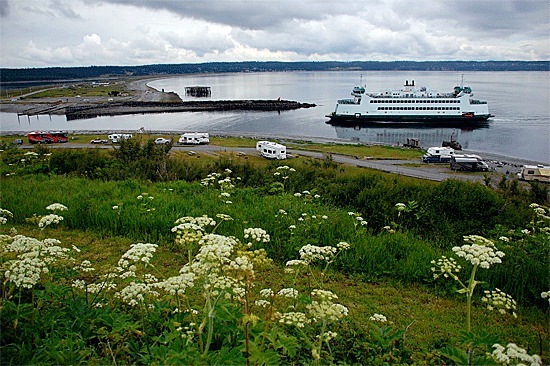Quarterly performance results for Washington State Ferries’ newest vessel, the $76.93 million Chetzemoka, may indicate that they really don’t make them like they used to.
Between Jan. 1 and March 31, the first full quarter the new boat was on the job, weather cancellations increased 30 percent over the same time period in 2007, which is the last year the antiquated Steel Electrics were running before they were retired for safety concerns.
In all, weather cancellations rose from 25 trips scrubbed four years ago to 36 this past spring. That compares to 26 in 2006 and 22 in 2005.
The Chetzemoka, the first of three Kwa-di Tabil class ferries to be built as replacements, went into service on the run this past November. Before its arrival, the run was operated by a smaller 50-car ferry. Due to its small size and limited capabilities, its cancellation history was not compared.
Marta Coursey, spokeswoman for Washington State Ferries, said in an email that comparing the Chetzemoka’s performance to previous years’ data is not an apt comparison. The Chetzemoka is a brand new vessel and it will take time for crews to get used to running it, especially in harsh weather conditions.
“The crews had 25 years of experience operating the Steel Electrics on the Port Townsend-to-Coupeville route – the most challenging route in our system,” Coursey wrote. “The Chetzemoka had only been in service a month and a half at the start of January 2011.”
Although Coursey could not say if the weather this past winter was any worse than in previous years, meteorologists have hailed this spring as one of the worst on record. However, the gauge is based on temperature – the number of days below 55 degrees – not the number of storms or strong-wind days, according to Clifford Mass, a professor of Atmospheric Sciences at University of Washington.
“We really haven’t had an exceptional number of storms,” Mass said.
Coursey said that it would be premature to speculate on how the vessel might operate in the future as day-to-day performance can be heavily dependent on ferry captains, as they “routinely make judgments to ensure the comfort and safety of our customers.”
Weather conditions unique to the Coupeville-to-Port Townsend ferry route make it by far the toughest route in the system.
The Anacortes-to-San Juan Islands run was the only other route with weather cancellations this spring. It recorded a total of two missed trips, compared to the 36 in Admiralty Inlet.
The Chetzemoka, modeled after the Island Home ferry on the East Coast, was designed with these challenges in mind. However, the increase in weather cancellations may be evidence of an Achille’s heel.
The vessel was made with fewer port holes on the car deck and with a large steel stairwell on the port side. While both were meant to improve fire safety, a byproduct is a noticeable list – ferry workers have nicknamed the boat I-lean – and a large sail area.
Mark Haupt, a senior captain with Washington State Ferries, speculated in November that they could lead to greater weather cancellations. Fortunately, his predictions that other improvements in the ferry design would lead to fewer tidal cancellations also proved true.
Thanks to its shallower draft, bigger engines and superior maneuverability, tidal cancellations fell from 68 trips in 2007 to 64 this spring. That compares to the 58 cancelled in 2006 and the 44 in 2005.
The Salish and Kennewick, the second and third Kwa-di Tabil-class ferries being built, should perform even better as they will come equipped with variable-pitch propellors, a technology designed to make them even more maneuverable.
The first quarter statistics also revealed that vehicle and passenger traffic has yet to recover from the years of limited service by a smaller, less reliable ferry. This quarter saw a total of 106,851 riders compared to 118,621 riders in 2007. That stacks up to the 126,204 rider in 2006 and the 133,112 in 2005.
Even though traffic numbers aren’t where they were four years ago, business leaders in Coupeville said no one really expected things to recover immediately.
“That’s a step in the right direction,” said Lynda Eccles, director of the Central Whidbey Chamber of Commerce.
As ridership was already showing a clear decline, from 2005 to 2007, it’s hard to know how factors such as the recession would have affected ridership had the Steel Electrics not been pulled from service.
Eccles said it probably would have decreased but certainly not to the degree that it did – 70,403 in 2008, 59,582 in 2009, and 98,654 in 2010.
She speculated that the trudging economy may be one of the factors hindering full ridership recovery. It may also just take some time for the public to regain trust that reliable service has been restored.
Whatever the case, Eccles said she very happy to see the increase over last year. The numbers may be rising slowly but at least they climbing at all.
“That shows things are improving,” Eccles said. “That’s really good actually; I’m happy with that.”



